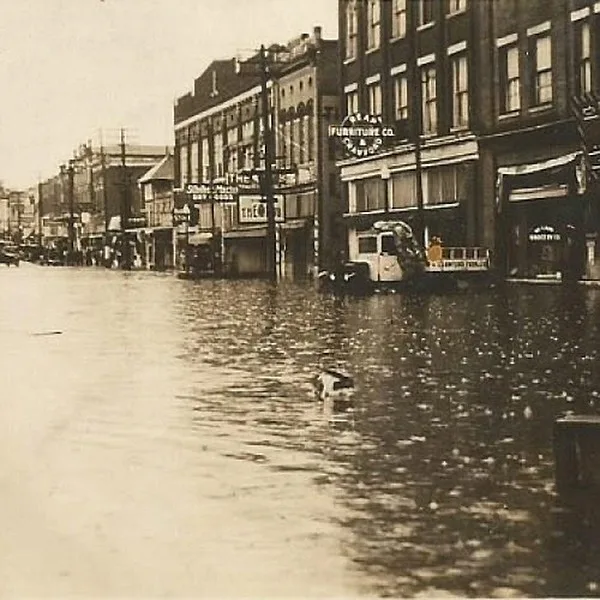
The Great Flood of 1927 was the most devastating and costly in U.S. history. The flood caused devastation in Arkansas, Illinois, Kentucky, Louisiana, Mississippi, Missouri, Oklahoma and Tennessee. The worst destruction occurred in Arkansas. Almost twice as much farmland was flooded in Arkansas as in Mississippi and Louisiana combined.
Beginning in the 1880s, a series of levees were constructed along the Mississippi River to prevent flooding. Low-lying swamps were cleared for timber and then used for farming. Farmers trusted the levee system and began planting their crops in the former flood plains, including the Arkansas Delta. In 1926, heavy rains covered the Midwest, filling the Mississippi River Basin as the water drained toward the Gulf of Mexico.
In the spring of 1927, heavy, early snowmelt from Canada caused the Mississippi River to swell. The White and Little Red rivers flooded. In April, Arkansas experienced record rainfall, with Little Rock receiving 7 inches of rain in a few hours. The saturated ground left the water nowhere to go, as lakes, riverbeds, and streams were already full. Eventually, the swollen Mississippi River backed up, overflowing the Arkansas, White and St. Francis rivers.
Every levee between Fort Smith and Little Rock collapsed as the floodwaters rushed into cities and fields. Many citizens had no time to escape and were forced to climb onto roofs and up trees as their belongings and livestock were washed away. Homes and businesses stood for months in 6 to 30 feet of murky water. Dead animals floated everywhere. Rich Arkansas farmland was washed away or covered in sand or mud.
The Great Flood of 1927 covered about 6,600 square miles, with 36 out of 75 Arkansas counties under water up to 30 feet deep in places. More than 350,000 people were displaced, over 2 million acres were affected, and more than 80 Red Cross refugee camps were needed to house displaced Arkansas residents. Arkansans required more relief and recovery funds than any other state. More than 41,243 families required aid. Approximately 100 people died in Arkansas, more than any state except Mississippi.
The Red Cross set up refugee camps all across Arkansas. In Pine Bluff, African American refugees camped at the Agricultural, Mechanical & Normal School, later UAPB. These segregated refugee camps were plagued with issues as the stagnant waters served as a breeding ground for mosquitoes carrying malaria and typhoid. Dysentery, smallpox and pellagra, a vitamin deficiency disease brought on by lack of protein, were also rampant because of the surrounding conditions.
African Americans living in tent cities received fewer provisions and were often forced at gunpoint to assist in the cleanup efforts. Black sharecroppers were admitted to and released from the camps only under the supervision of their planters as white planters feared losing their labor force. On Sept. 15, Arkansans were finally able to return to their devastated land to try to survive the winter and start over with virtually nothing.
Thousands of African American laborers left the South, moving to Northern cities in search of better-paying jobs and living conditions. The Great Flood of 1927 also shifted a great deal in government and politics.
President Calvin Coolidge and his administration were criticized for providing no federal relief and contributing little to relief efforts. Herbert Hoover, his secretary of commerce, used the notoriety he gained from his management of the flood to win the presidential election in 1928.
Many African Americans also switched their political support from Republican to Democrat. In 1928, Congress enacted the Flood Control Act, which put the U.S. Army Corps of Engineers in charge of rebuilding the levees along the Mississippi. The Corps of Engineers built a series of 29 locks and dams and hundreds of canal runoff channels to avoid such massive flooding. After the Great Depression, an even greater push for flood control created many of the dams in Arkansas.
Lastly, the Great Flood of 1927 also birthed the creation of many blues and gospel songs, including “The Flood Blues” by Arkansas native Sippie Wallace, which captured the despair of Black Southerners after the flood.
This article is from ExplorePineBluff.com, a program of the Pine Bluff Advertising and Promotion Commission. Sources: https://encyclopediaofarkansas.net — Flood of 1927; https://onlyinark.com — The Great Flood of 1927; https://sundayblues.org — HIGH WATER EVERYWHERE Blues and Gospel Commentary on the 1927 Mississippi River Flood pdf; Image Credit: EncyclopediaofArkansas.net.
Ninfa O. Barnard wrote this article for Explore Pine Bluff.com.

